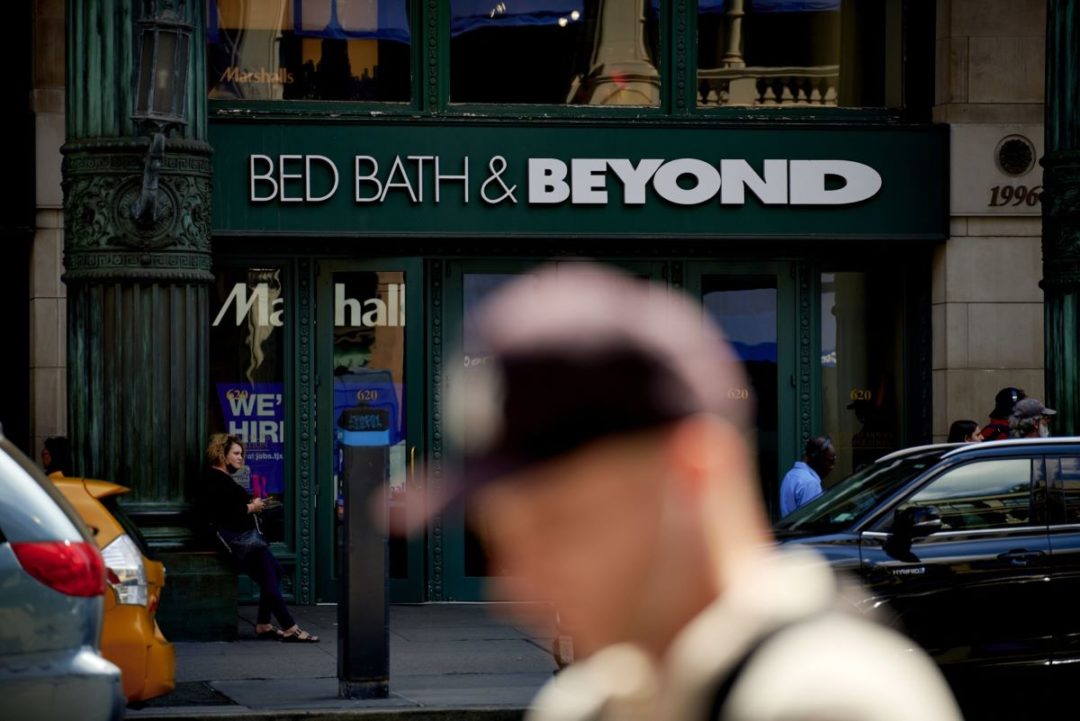
Visit Our Sponsors |
|
|
|
|
|
|
|
|
|
|
|
|
|
|
|
|
|
|
|
|
|
|
|
|
|
|
|
|
|
|
|
|
|
|
|
|
|
|

Bed Bath & Beyond Inc. unveiled a turnaround plan that envisions new financing, sweeping store closings and the sale of as many as 12 million shares of stock, delivering another jolt to the investors who had piled into the retailer even as its troubles mounted.
The home-goods retailer said it has received commitments for a new $375 million “first-in-last-out” facility with Sixth Street Partners and around $130 million to expand an asset-based revolving credit facility, which is led by JPMorgan Chase. The company said the loan deal hasn’t closed yet but is expected to soon.
The company is also preparing to sell up to 12 million shares via Jefferies to help repay debt. The threat of the stock value being further watered down sent investors into a tailspin Aug. 31, with the shares down 20% as of 11:51 a.m. in New York.
The share price plunge marked a fresh wake-up call for the so-called meme traders who propelled Bed Bath & Beyond to a 141% gain this month through Aug. 30 — looking past the company’s shrinking cash pile and tardy vendor payments that prompted some suppliers to halt or restrict shipments. The air began coming out of the balloon after activist shareholder Ryan Cohen disclosed this month that he was selling his stake.
“We are working swiftly and diligently to strengthen our liquidity and secure our path for the future,” interim Chief Executive Officer Sue Gove said in a statement.
The company said it plans to use the proceeds from the first-in-last-out facility to help pay down its asset-backed facility. In the case of a default, lenders in the first-in-last-out facility get what remains after higher-ranking secured debt is repaid in full.
Cost-Cutting Plans
To boost falling sales and cut costs, Bed Bath & Beyond is cutting 20% of jobs across its corporate and supply-chain operations and closing about 150 lower-producing stores.
The Union, New Jersey-based company said Aug. 31 that it has decided to keep its Buybuy Baby brand despite calls for it to be sold. The division has fared better than the company’s namesake brand. While comparable sales at the Bed Beth & Beyond brand plunged by 27% in the quarter that ended in May, comparable sales at Buybuy Baby fell by just mid-single digits.
“Not having to sell the Buybuy Baby chain to raise funds is a win, mainly because this is a stronger part of the business that has the potential to do well,” GlobalData analyst Neil Saunders wrote in a research note. “It will also remain as an asset that, if necessary, can be sold further down the line — perhaps at a time that is more conducive to maximizing its value.”
Preliminary sales in the quarter ended Aug. 27 were $1.45 billion. That’s below the average analyst estimate of $1.50 billion.
‘Worst Possible Time’
The highest inflation in four decades and incessant supply-chain problems have dimmed the outlook for many U.S. retail companies. But Bed Bath & Beyond’s woes are the culmination of a series of missteps by executives in recent years. Those problems are now exacerbated by slowing consumer demand for home goods.
The company’s financing arrangements “buy space and time, but they do not buy a solution to the group’s wider issues,” Saunders wrote. “Bed Bath & Beyond is reinventing itself at the worst possible time.”
Read more: U.S. Retailers Plan Big Discounts as Inflation, Inventory Add Up
Former CEO Mark Tritton boosted the company’s private-label products while trimming its offering of well-known brand names and also cut back on coupons, among other changes. But his attempt at a turnaround was unsuccessful. After two-and-a-half years at the helm, he exited abruptly earlier this summer. Gove, a board member, stepped in to temporarily run the business.
Customers missed the household names that had drawn them to Bed Bath & Beyond in the first place and the availability of the company’s private-label products was inconsistent during the pandemic. Those items typically take longer to arrive in stores since they are often sourced in Asia. As a result, the company was unable to take advantage of surging demand when shoppers were stuck in their homes. Now, it has too much inventory, which executives have said they aim to sell down during the holiday season.
Bed Bath & Beyond said Aug. 31 that it plans to discontinue three of its nine private labels. It will also boost the availability of national brands in the long term and expects to have some exclusive products among its top brands.
RELATED CONTENT
RELATED VIDEOS
Timely, incisive articles delivered directly to your inbox.






